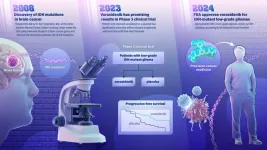(Press-News.org)
A blood test can help predict which preterm babies will go onto develop chronic lung disease, allowing for earlier diagnosis and more targeted treatments, according to a new study.
The research, led by Murdoch Children’s Research Institute (MCRI) and published in the American Journal of Respiratory Cell and Molecular Biology found that changes in certain blood proteins, alongside gestational age, birth weight and sex, strongly predicated bronchopulmonary dysplasia (BPD) within 72 hours of life.
BPD usually occurs when a baby’s lungs are damaged by respiratory support and the long-term use of oxygen. The disease affects 65 per cent of preterm infants and results in lifelong chronic lung disease and neurodevelopmental disabilities.
The study, which examined 493 blood proteins, involved 23 babies born before 29 weeks’ gestation at the Royal Women’s Hospital. Changes found in 49 of these proteins were detected in babies who later developed BPD. Some differences were noticeable within four hours of a baby being born.
MCRI’s Dr Prue Pereira-Fantini said the study provided a comprehensive map of what occurred in babies with BPD and gave valuable insight about key biological changes in the first few days of life.
“Our ability to predict, prevent and treat BPD is limited,” she said. The tool currently used for early prediction of BPD severity currently fails to look at the disease pathology.
“A BPD diagnosis is usually made at 36 weeks post-menstrual age, which limits potential treatments that can minimise lung injury and improve respiratory outcomes. Our team was able to identify certain proteins in the blood, which when combined with other key birth measures, may predict BPD as early as four hours post-birth.”
MCRI Professor David Tingay said the ability to more accurately predict BPD within the first days of life may allow for earlier diagnosis, more targeted treatments and better-informed counselling for families.
“Changes in BPD rates can be achieved if appropriate lung protective interventions are provided at the right time,” he said. We can better tailor the care of these babies when we know how likely they are to experience lung damage and other complications.”
The team are now looking to create a lung injury assessment tool that could be used to assess all preterm babies admitted to a Neonatal Intensive Care Unit (NICU) or special care nursery for risk of BPD.
“The tool, including a blood test, would provide clinicians with the ability to guide respiratory decisions from birth, giving these babies more chances towards a healthy life,” Dr Pereira-Fantini said.
“Early intervention is likely to be more effective at preventing or minimising the severity of BPD and its long-term health and medical effects.”
Simantha Nation’s son Atticus was born at 26 weeks gestation, weighing just 807 grams. Born very preterm, Atticus struggled to breathe from his first gasp for air.
Atticus was rushed to the NICU, where he was intubated and connected to a ventilator.
The first time Simantha laid eyes on him, he was covered in tubes and wires.
“It was devastating to see that Atticus couldn’t breathe on his own,” she said. Watching your tiny baby battle severe, chronic lung disease was heartbreaking.
“As the weeks in the NICU turned into months his condition wasn’t improving. He was reliant on a specialised ventilator to keep him alive.”
When Atticus reached five months, Simantha thought her son would lose his battle with lung disease.
“His health took a dire turn and his condition became critical,” she said. We were told by staff to say our goodbyes in case he didn’t make it through the night. I can’t tell you how hard it was, holding him for hours and not being sure if it was the last time.”
But Simantha said in the following days Atticus continued to get better, little by little. After 263 days in the NICU she was finally able to take him home.
“Atticus was tied to a machine for almost his entire hospital stay,” she said. He still has a tracheostomy to help him breathe through his throat instead of the nose and mouth. Due to this he is is learning AUSLAN to communicate.
“But Atticus is thriving at home and reaching key developmental milestones. His progress has been incredible, he has come so far.”
Simantha said the latest MCRI lung disease research was a remarkable discovery.
“Any research that can help babies breathe, or understand their risks sooner, would be incredible and something all parents and carers of preterm babies can take comfort in,” she said.
Researchers from the University of Melbourne, the Royal Women’s Hospital and The Florey Institute of Neuroscience and Mental Health also contributed to the findings.
Publication: Prue Pereira-Fantini, Sean Bryars, Omar Kamlin, Brett Manley, Peter Davies and David Tingay. ‘Plasma proteome profiles associated with early development of lung injury in extremely preterm infants,’ AJRCMB. DOI: 10.1165/rcmb.2024-0034OC
*The content of this communication is the sole responsibility of the Murdoch Children’s Research Institute and does not reflect the views of the NHMRC.
Available for interview:
Dr Prue Pereira-Fantini, MCRI Team Leader, Discovery & Diagnostics
Professor David Tingay, MCRI Group Leader, Neonatal Research
Simantha Nation whose son Atticus, 18 months, was born very preterm
END
New research from a team of genome scientists and DNA damage response experts breaks new ground in understanding the function of a protein currently limited in clinical trials for cancer treatments.
Led by Haichao Zhao, PhD, in the Yan Lab at UNC Charlotte, the new research shows how ATM-mediated signaling is induced by DNA single-strand breaks (SSBs) for DNA damage repair – illuminating the distinct mechanisms of SSB-induced ATM kinase and shedding an important light on APE1 function.
In the new study, published today in Nature Communications, ...
SOUTHFIELD, MI, Aug. 7, 2024 - New Corewell Health™ research suggests an MRI scan can help predict whether patients with intermediate-risk prostate cancer (cancer confined to the entire prostate) may have more aggressive cancer in five years. Knowing this could potentially help doctors determine if treatment is needed up front vs. using a method called active surveillance where the disease is closely monitored over time. The study, recently published in the Journal of Urology, is the first to evaluate this risk group.
Currently, there has been a growing trend to manage low-risk prostate cancer patients with active ...
FOR IMMEDIATE RELEASE
A new drug for treatment of a type of brain cancer, called IDH-mutant low-grade glioma, was approved Aug. 6 by the U.S. Food and Drug Administration (FDA). The promising new drug stems from a 2008 genetic discovery made at the Johns Hopkins Kimmel Cancer Center.
The drug, called vorasidenib, is a targeted cancer therapy that works by inhibiting the activity of a mutated gene called IDH, slowing the growth of the cancer. The gene was identified by Bert Vogelstein, M.D., and team at the Johns Hopkins Kimmel Cancer Center’s ...
INDIANAPOLIS -- Regenstrief Institute’s latest LOINC® content update underscores significant strides in health terminology, accomplished through extensive collaboration with the international health community. The semiannual release aims to bolster the electronic exchange of clinical and laboratory data, fostering the use and implementation of LOINC standards across healthcare systems globally.
The Regenstrief Institute Health Data Standards (HDS) unit, which administers LOINC, and partners collaborated to create more than 3,000 updates, including ...
Pesticides and herbicides are critical to ensuring food security worldwide, but these substances can present a safety risk to people who unwittingly ingest them. Protecting human health, therefore, demands sensitive analytical methods to identify even trace levels of potentially harmful substances. Now, researchers reporting in ACS’ Nano Letters have developed a high-tech imaging method to detect pesticide contamination at low levels, and its application on fruits reveals that current food safety practices ...
East Hanover, NJ – August 7, 2024 – Kessler Foundation research scientist John DeLuca, PhD, has published a significant clinical article in Journal of Neurology, shedding light on the elusive nature of fatigue in multiple sclerosis (MS) and its implications for treatment. The study provides a comprehensive review of current challenges in defining, measuring, and treating MS-related fatigue, offering new insights and directions for future research.
The open access article, “Fatigue in multiple sclerosis: can we measure it and can we treat it?” (Doi: 10.1007/s00415-024-12524-9), was published on July ...
A National Institutes of Health (NIH)-supported study has found race- and sex-based differences in the increased chances of survival from people who received bystander cardiopulmonary resuscitation (CPR) for out-of-hospital cardiac arrest. Average survival benefits for cardiac arrest, when the heart suddenly stops beating, could be three times as high for white adults compared to Black adults and twice as high for men compared to women. The findings published in Circulation.
“CPR saves lives — that, we know,” said Paula Einhorn, M.D., a program officer at NIH’s National, Heart, Lung, and Blood Institute ...
Florey researchers have found evidence of higher levels of the plastic chemical bisphenol A (BPA) in pregnant mothers who gave birth to sons with autism.
Research published in Nature Communications, led by Florey scientists Dr Wah Chin Boon and Professor Anne-Louise Ponsonby, supports the hypothesis of a possible link between autism and exposure to plastic chemicals in the womb.
Professor Ponsonby said the researchers analysed two large birth cohorts – the Barwon Infant Study (BIS) in Australia and the Columbia Centre for Children’s Health and Environment in the USA.
“Exposure to plastic chemicals ...
BUFFALO, N.Y. — Our energy future may depend on high-temperature superconducting (HTS) wires. This technology’s ability to carry electricity without resistance at temperatures higher than those required by traditional superconductors could revolutionize the electric grid and even enable commercial nuclear fusion.
Yet these large-scale applications won’t happen until HTS wires can be fabricated at a price-performance metric equal to that of the plain copper wire sold at your ...
The composition of gut bacteria of Thoroughbred racehorses at one-month-old can predict their future athletic performance, according to a new study from the University of Surrey. Foals with lower bacterial diversity at 28 days old also had a significantly increased risk of respiratory disease later in life.
Researchers from Surrey's School of Veterinary Medicine and School of Bioscience, led by Professor Chris Proudman, investigated the composition of gut bacteria in Thoroughbred foals bred for flat ...





